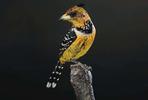
Appearance
With its thick bill and and very colourful plumage the Crested Barbet is unmistakeable. This small bird has a speckled yellow and red face with a small black crest. The belly is yellow with red speckles, wings are black with white specks and it has a broad black band on its neck. Yellow head and body with black and white feathers, red markings on end of body, its colour blends well in the bush. They have a distinct shrill.Diet
The Crested Barbet feeds on Insects, other birds eggs and fruits.Breeding
Crested Barbet nest in a hole in a tree or a Sisal log in a garden. They are monogamous and territorial during breeding. Territory size varies according to their habitat. Eggs are laid between September to December. 1 to 5 eggs are laid at daily intervals. Incubation lasts between 13 to 17 days, beginning with the second or third egg and mainly by the female. The young hatch naked and blind. They are fed insects by both parents. Faecal material is removed regularly. They fledge after about 31 days. Up to five broods have been recorded in a breeding season.

